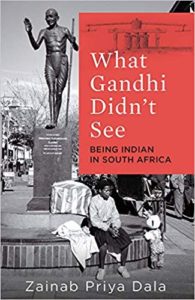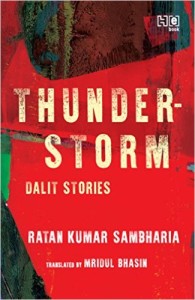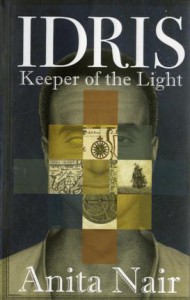Zainab Priya Dala’s “What Gandhi Didn’t See: Being Indian in South Africa”
 Like a white net veil worn over a red saree, or an ivory satin gown sleeve that borders ornate paisley mehndi patterns, the people of Indian origin in South Africa evolved from holding tightly onto the shreds of Indian culture that they came with inside locked boxes and sewn into hemlines. But, like all migrants, or perhaps refugees the world over, evolution is the Holy Grail, the ability to blend into the current social strata. The result became the South African Indian. A mix of names formed and re-formed, and clothing worn and then not worn, and eventually as apartheid was abolished, an identity searched for and still to be found.
Like a white net veil worn over a red saree, or an ivory satin gown sleeve that borders ornate paisley mehndi patterns, the people of Indian origin in South Africa evolved from holding tightly onto the shreds of Indian culture that they came with inside locked boxes and sewn into hemlines. But, like all migrants, or perhaps refugees the world over, evolution is the Holy Grail, the ability to blend into the current social strata. The result became the South African Indian. A mix of names formed and re-formed, and clothing worn and then not worn, and eventually as apartheid was abolished, an identity searched for and still to be found.
South African writer Zainab Priya Dala’s What Gandhi Didn’t See: Being Indian in South Africa is a collection of essays that are a mix of memoir, sharing opinions on the changing political landscape and the growth of Dala as a writer. These essays are sharply written detailing the complicated histories South African citizens of Indian origin have to contend with on a daily basis. It informs their identity. Even details such as if their ancestors came as “indentured labourers” or as “passenger Indians” makes a world of difference to their sense of identity in a foreign land. Zainab Priya is of mixed parentage as her father is a Hindu and her mother a Muslim. Later she married in to a well-established Muslim business family who had come to South Africa relatively recently but she regularly encounters variations between the families in their habits and living styles.
What Gandhi Didn’t See: Being Indian in South Africa is a slim collection of powerfully written essays. These essays by a South African Indian reflecting upon multiple aspects of her existence is much like this book being the sum of many parts of her life — mother, wife, daughter, writer, activist, migrant, political awakening etc ( and not necessarily in the given order of importance). Fact is the moment you are aware of your personal histories the complexities of one’s ancestry become evident and it is no longer quite as simple to speak of genealogies in puritanical terms or of political action in black and white terms of “us and they”. Zainab Priya Dala is sharply articulate about these complex inheritances and is very aware of the fine negotiations it demands of her on a daily basis which is a given way of life. And it is precisely these day-to-day exercises in living that also sharply bring home to her details in society that Gandhi was blinded by. The South Africa in which he honed his political activism was primarily aimed at the racist modes of governance and not necessarily at recognising the microcosm of South African or South African Indian society and its distinct threads of identity. Curious that Gandhi who otherwise was so very sensitive missed these finer distinctions of identity especially since he and the author both have links to the Gujarati community. Yet for Gandhi it was apartheid of far more importance and it remained so till the 1990s when many of the South African social structures were realigned. In the new era it is not so much as race governing lines of social separation but money. With money becoming the defining factor of ancestries and communal make-up become even more acutely apparent. And as in the jungle, it is the survival of the fittest, same holds true for civil society. Those who survive in the new socio-economic terrain are also confident of their identity while aware of their historical, soci-political and genetic inheritances — a fact that Zainab Priya Dala is clear she will spell out for her children.
What Gandhi Didn’t See: Being Indian in South Africa is a sharp commentary on contemporary South Africa. It must be read. The thought-provoking essays will resonate with many readers especially women, across nations. Also for how smartly it puts the reader under the scanner and forces them to question and understand their inherited narratives better.
Read an extract from the book used with permission from the publishers — Speaking Tiger Books.
****
My father, a third generation non-resident Indian, whose grandfather had come from a village near Gorakhpur in Uttar Pradesh, preferred not to talk much about his heritage. But, things changed when he reached sixty years of age. Why? I will never know. But what I do know is that everything about my heritage from my paternal side had been spoken of by others, including my father’s brothers and sisters, not him. Maybe, he suffered the affliction of a love marriage to a woman who was seen as superior to him, and he wanted to delete his inferiority in the eyes of his children. But, I am seeing now how I also do the similar thing to my children. My husband, like my mother, comes from the big city of Durban, and his heritage is one of the Muslim business class that came to South Africa long after the indentured labourers** and anyway, let me just say it – he is considered higher class than I am, so we tend to appropriate this onto our children. Perhaps my father had done the same for many years. And, perhaps he decided to speak openly about our mixed up heritage only after my sister and I were safely and happily stowed away into good marriages. Things are sometimes as ugly as that. But speak he did. It became a river that never stopped. One day a year ago we were at a fancy dinner party held by my cousin from my mother’s side of the family – a very rich and successful doctor amongst a family of doctors. He lived in an area we still call today a White Area, which means that before 1994, none of us would have ever dreamed of walking past a house there, let alone living in one. My father was quiet during this dinner, but perhaps a few glasses of expensive whiskey loosened his tongue, and he started talking about his childhood on the farm. My mother tried to quieten him, not because she was ashamed, but because she knew he was about to cry. The room went silent as if a spell had been cast by a mournful farm-accented voice ringing out among the posh “white” accents of my cousins and his friends. But, minutes into his monologue, my cousin’s husband blurted:“Oh really now, Babs, should we get you an audition for another ‘Coolie Odyssey’?” (‘The Coolie Odyssey’ was a play on the indentured labourers written, directed by, and starring, Rajesh Gopie, a South African Indian dramatist).
My father fell into silence, and my husband, who is sensitive to the point of extreme protection of my father at most times, ushered him outside. I was carrying my baby son, and looking at these two men, standing next to a Balinese-inspired swimming pool, sharing a cigarette and probably chatting about the price of fuel, it was not lost on me that I was carrying in my arms the actual reality of a class divide. My son will always have to negotiate this divide and there is nothing I can do to protect him from it. Why would I need to protect him? Well, to put it as succinctly as I can, in South Africa, we let go of the caste system in the bowels of a ship in the 1800s, but we adopted a system that became very insidious. Fellow writers and historians, Ashwin Desai and Goolam Vahed in their detailed opus, Inside Indenture, A South African Story 1860 – 1914, describe these people who dropped their caste into the Indian Ocean as “twice-born.” Here, they refer to the fact that in the shiphold, there was no room for caste or class. An Indian inside there was an Indian who ate and slept alongside all others. But once they arrived at the port, and the documents of demographics were being created, a lower caste could easily take himself up a few notches. Today, in contemporary South Africa, caste is obsolete. We all know enough by now to question the Maharaja and Singh surname with a studied eye for actual refinement in behaviour, language and of course education. This does not mean there are no divisions. The divisions go deep. They are based on religion, economics, language and colour. Of course, I know that these divisions are changeable ones– much like dropping your caste at a shipyard, now you can change your religion, think and grow rich, lighten your skin and perfect your English. This malleability scares the ones who wielded class like gold crowns. I admit, my maternal family and my husband’s family are those that did. They are forgiven because they didn’t know they were doing it.
In South Africa, the business class came to the shores of Natal mainly from the villages of Gujarat. My father-in-law describes it well when he tells me in thick Gujarati: “One side of the street is Muslim Desai family. Opposite side of street is Hindu Desai family. Both Desais understand each other and get along better than even Muslim Urdu speakers or Calcuttiah people.”
I don’t look at anything he is saying as derogatory. The reason is that he is not insulting anyone, he is simply stating facts. The Gujarati community aggregated together in a code of business and called each other “Aapra-wallahs’. They still use this term today. An acquaintance, who is a great-grandson of Mahatma Gandhi, once came over to my house to collect items I wanted to donate to a family rendered homeless after a fire. I had known him for some years, and had interacted with him many times on charitable or literary correspondence. But, within minutes of the mutual spotting of an Aapra-wallah in the room, I ceased to exist in the conversation. My husband, a Muslim, and my associate, a Hindu, both spoke Gujarati that went far above my head. I had learned the basics of the language, to communicate with my husband’s family who spoke only Gujarati. My mother’s family were too high class to speak any vernacular, and only the Queen’s English would do. My father’s family spoke a combination of Urdu, Hindi and Bhojpuri. My best friend spoke Afrikaans and the children I grew up playing with spoke Zulu. Add to this mix the terms that each of us reserved for each grouping, which are as derogatory as being called Coolies, and it is no wonder that I cannot sleep some nights.
Indians who left as indentured labourers from the port of Calcutta are called Calcuttiahs, and Indians who left as indentured labourers from the port of Madras are called Madrasis. The Muslim community have their own lines of division and I find that these lines are deeply hurtful. Muslims who arrived in South Africa as indentured labourers are thought to come from Hyderabad. Although many chroniclers say that the majority of the Muslim community in South Africa who are not business arrivals are actually converts to Islam. This is how the Muslim community divide their people – colour and language. It used to be money, but now everyone is keeping up with the Joneses and the famous Gujarati Trust Funds** are running on empty, having cossetted very large and extravagant families for two generations.
The Memon Muslim community is a very small one, but they wield a large economic clout. They are known to have come from different areas around India, originally from Kathiawar, but finally settled as a community near Porbandar in Gujarat, from where a number of them migrated to South Africa as traders and businessmen. Another batch of Gujarati Muslims came from different villages in Gujarat, and left for South Africa from the port of Surat. They proudly refer to each other as Surtis and use the term “Hedroo,” to describe any other Muslim who is not Gujarati or Memoni. Hedroos, a terrible term, is used to speak of the class of Muslims whom the Surti community look upon as low class and poor. Inter-marriages between Surtis and Hedroos are still frowned upon. I am reminded of my own wedding day, when my husband’s aunt told me that in the history of the Dala family, it was the first time they had accepted a “mixed” girl for any of their boys. Their bloodline had remained pure Gujarati till 2006, the year of my nikkah. I responded to the aunt by a small nod that day, and replied to her: “Hahn ji.”
***
Footnotes
**Over 100,000 Indians arrived as slaves from the subcontinent in 1684 and lived in Cape Town. The first Indian indentured labourers arrived on 16 November 1860.The passenger/ trader Indians began arriving around 1875 to meet the need for commercial trade in the community, Black and Indian as well as Coloured.
**Gujarati Trust Funds were set up from the mid 1870s by wealthy Gujarati families, to cater for all educational, medical and housing needs of their community. When Gandhi arrived in South Africa, the Gandhi Trust was set up to cater for legal needs and to publish a newspaper called The Indian Opinion.
Zainab Priya Dala What Gandhi Didn’t See: Being Indian in South Africa Speaking Tiger, New Delhi, 2018. Hb. pp. 150. Rs 499
27 November 2018






